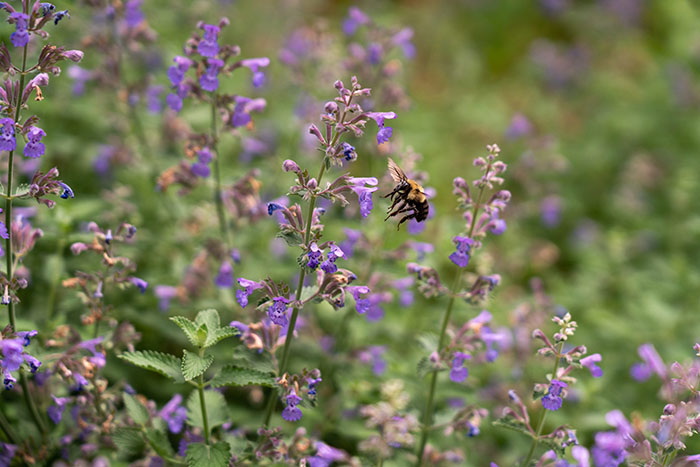Garden Talk
Horticultural Highlight: Catmint

In this series, the staff of Duke Gardens highlights plants you’ll find within our 55-acre living collection. This week education program coordinator Kavanah Anderson features catmint, an easy to grow perennial that attracts many buzzing pollinators.

Botanical name: Nepeta racemosa ‘Walker’s Low’ and Nepeta x faassenii
Common name: Catmint
Family name: Lamiaceae (Mint Family)
Plant type: Herbaceous perennial
Location in Duke Gardens: Mary Duke Biddle Rose Circle, Doris Duke Center Gardens, Terrace Gardens
Site requirements: Full sun to part shade
USDA Hardiness Zones: 4-8
During the school year, Duke Gardens becomes a classroom for more than 5,000 elementary school students. It’s a place where they can sharpen observation skills, see plant and animal life cycles, practice math skills, record their experience with words and images, and learn outside. Yet many students arrive with a fear of bees and other insects, which can get in the way of learning.
Their trepidation can often be eased through exposure and understanding. My favorite plant in the gardens to help dispel a fear of bees is catmint (not to be confused with catnip). On sunny days from April through mid-October, the flowers of Nepeta racemosa and Nepeta x faassenii are visited by pollinators of many varieties, but particularly bees. Honeybees, sweat bees, bumblebees, leaf cutter bees, mason bees, various wasps, butterflies and even hummingbirds are attracted to their spikes of purple flowers.
When bees find a nectar source, they often travel from flower to flower until they have collected their fill, and a small patch of catmint provides hundreds of flowers for the bees to explore. When students see that the bees are so busy sipping nectar and collecting pollen, it becomes clear they have no interest in stinging us and curiosity kicks in. Students can count the six legs and identify the head, thorax and abdomen to confirm it is an insect. They can see how pollen gets stuck on the tiny hairs coating the bees’ bodies and they can watch how bees dip their proboscis into flowers to sip nectar. They can see honeybees and bumblebees pressing pollen into the pollen baskets on their hind legs. It becomes a counting game—how many different species of bees can you find? Their fear transforms into confidence, excitement for learning, and an appreciation of the relationship between plants and animals.
There are a number of reasons to add catmint to a garden beyond its attraction of pollinators. The strong scent of the leaves repels pests, including aphids, rabbits, voles and deer. The silvery green, aromatic foliage of catmint makes it a great option to plant along garden edges, borders, and even as ground cover in small patches. It is an easy to grow, drought tolerant plant that can thrive in full sun to part shade in dry, low-nutrient soil. Opposite leaves on a square stem are a clue that it is in the mint family. The botanical name is thought to refer to the Italian city of Nepi (formerly Nepete), which was once the center of the Etruscan rule.
Sources: Missouri Botanical Garden
Piedmont Master Gardeners
Extension.org
Photos by Jason Holmes (below) and Clarence Burke.







